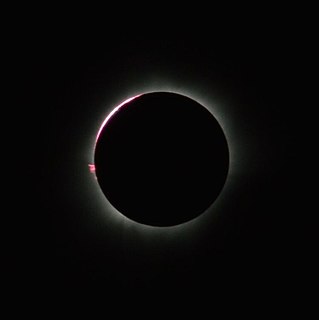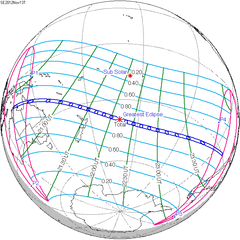
A total lunar eclipse occurred on February 20 and February 21, 2008. It was visible in the eastern evening sky on February 20 for all of North and South America, and on February 21 in the predawn western sky from most of Africa and Europe. Greatest Eclipse occurring on Thursday, February 21, 2008, at 03:26:03 UTC, totality lasting 49 minutes and 45.6 seconds.

A partial lunar eclipse took place on 16 August 2008, the second of two lunar eclipses in 2008, with the first being a total eclipse on 20 February 2008. The next lunar eclipse was a penumbral eclipse occurring on 9 February 2009, while the next total lunar eclipse occurred on 21 December 2010.

A total lunar eclipse took place on Sunday 9 November 2003, the second of two total lunar eclipses in 2003, the first being on 16 May 2003. It is the first total lunar eclipse of 21st century which happened on a micromoon day. The Moon barely edged into total eclipse for 21 minutes and 58 seconds. With the Moon just 1.78% of its diameter into the Earth's umbral shadow, the Moon may have been quite bright, but even so, this should have been worth seeing. The partial eclipse lasted for 3 hours, 31 minutes and 25 seconds. Occurring only 1.4 days before apogee, the Moon's apparent diameter was 6.4% smaller than average.

A partial lunar eclipse was visible on 31 December 2009. It was the last and largest of four minor lunar eclipses in 2009. This lunar eclipse was also notable, because it occurred during a blue moon and was near perigee. The next eclipse on New Year's Eve and blue moon will occur on 31 December 2028.

An annular solar eclipse occurred at the Moon's ascending node of the orbit on Monday, January 26, 2009. A solar eclipse occurs when the Moon passes between Earth and the Sun, thereby totally or partly obscuring the image of the Sun for a viewer on Earth. An annular solar eclipse occurs when the Moon's apparent diameter is smaller than the Sun's, blocking most of the Sun's light and causing the Sun to look like an annulus (ring). An annular eclipse appears as a partial eclipse over a region of the Earth thousands of kilometres wide. It had a magnitude of 0.9282 and was visible from a narrow corridor beginning in the south Atlantic Ocean and sweeping eastward 900 km south of Africa, slowly curving northeast through the Indian Ocean. Its first landfall was in the Cocos Islands followed by southern Sumatra and western Java. It continued somewhat more easterly across central Borneo, across the northwestern edge of Celebes, then ending just before Mindanao, Philippines. The duration of annularity at greatest eclipse lasted 7 minutes, 53.58 seconds, but at greatest duration lasted 7 minutes, 56.05 seconds.

A penumbral lunar eclipse took place at the Moon's ascending node on 11 February 2017, the first of two lunar eclipses in 2017. It was not quite a total penumbral lunar eclipse. It occurred the same day as comet 45P/Honda–Mrkos–Pajdušáková made a close approach to Earth. It also occurred on the Lantern Festival, the first since 9 February 2009. Occurring only 4.4 days after perigee, the moon's apparent diameter was larger.

A partial lunar eclipse took place at the Moon's descending node on the evening of 7 August and the morning pre-dawn on 8 August 2017, the second of two lunar eclipses in 2017. The Moon was only slightly covered by the Earth's umbral shadow at maximum eclipse. The Moon's apparent diameter was smaller because the eclipse occurred only 5 days after apogee.

A total lunar eclipse occurred on Tuesday, 8 November 2022. The southern limb of the Moon passed through the center of the Earth's shadow. It surpassed the previous eclipse as the longest total lunar eclipse visible from nearly all of North America since 17 August 1989, and until 26 June 2029. Occurring only 5.8 days before apogee, the Moon's apparent diameter was smaller. The next total lunar eclipse will take place on 14 March 2025. A lunar occultation of Uranus happened during the eclipse. It was the first total lunar eclipse on Election Day in US history. This event was referred in media coverage as a "beaver blood moon".

A total lunar eclipse will take place on July 7, 2047. It will last 1 hour 40 minutes and 49 seconds and will plunge the full Moon into deep darkness, as it passes right through the centre of the Earth's umbral shadow. While the visual effect of a total eclipse is variable, the Moon may be stained a deep orange or red colour at maximum eclipse. This will be a great spectacle for everyone who sees it. The partial eclipse will last for 3 hours and 39 minutes in total.
A partial lunar eclipse took place on Friday, July 17, 1981, the second of two lunar eclipses in 1981. The Earth's shadow on the Moon was clearly visible in this eclipse, with 55% of the Moon in shadow; the partial eclipse lasted for 2 hours and 43 minutes.
A penumbral lunar eclipse took place on Thursday, March 3, 1988, the first of two lunar eclipses in 1988, the second being on August 27, 1988. Earlier sources compute this as a 0.3% partial eclipse lasting under 14 minutes, and newest calculations list it as a penumbral eclipse that never enters the umbral shadow. In a rare total penumbral eclipse, the entire Moon was partially shaded by the Earth, and the shading across the Moon should have been quite visible at maximum eclipse. The penumbral phase lasted for 4 hours, 53 minutes and 50.6 seconds in all, though for most of it, the eclipse was extremely difficult or impossible to see. The Moon was 2.2 days after apogee, making it 6.1% smaller than average.
A penumbral lunar eclipse took place on Thursday, November 8, 1984, the last of three lunar eclipses in 1984. This subtle penumbral eclipse may have been visible to a skilled observer at maximum eclipse. 90% of the Moon's disc was partially shaded by the Earth, which caused a gentle shadow gradient across its disc at maximum; the eclipse as a whole lasted 4 hours and 28 minutes.
A penumbral lunar eclipse took place on Tuesday, May 15, 1984, the first of three lunar eclipses in 1984. This was a deep penumbral eclipse, with the southern limb of the Moon close to the Earth's shadow.
A penumbral lunar eclipse took place on Tuesday, January 20, 1981, the first of two lunar eclipses in 1981. In a rare total penumbral eclipse, the entire Moon was partially shaded by the Earth, and the shading across the Moon should have been quite visible at maximum eclipse. The penumbral phase lasted for 4 hours and 24 minutes in all, though for most of it, the eclipse was extremely difficult or impossible to see. The moon's apparent diameter was larger because the eclipse occurred 5.2 days after perigee.
A total lunar eclipse took place on Friday, November 29, 1974, the second of two lunar eclipses in 1974. The Moon was plunged into darkness for 1 hour, 15 minutes and 45 seconds, in a deep total eclipse which saw the Moon 28.961% of its diameter inside the Earth's umbral shadow. The visual effect of this depends on the state of the Earth's atmosphere, but the Moon may have been stained a deep red colour. The partial eclipse lasted for 3 hours, 28 minutes and 58.7 seconds in total. The penumbral eclipse lasted for 5 hours, 33 minutes and 11.6 seconds. The partial eclipse lasted for 3 hours, 28 minutes and 58.7 seconds. The total eclipse lasted for 1 hour, 15 minutes and 45 seconds. Occurring only 3.6 days before perigee, the Moon's apparent diameter was 1.4% larger than average.

A penumbral lunar eclipse took place on 30 November 2020. A penumbral lunar eclipse occurs at full moon when the Moon passes through Earth's penumbral shadow.

A partial lunar eclipse will take place on November 30, 2039. At 3 hours 26 minutes, it is the longest partial lunar eclipse since November 19, 2021, which is the previous member of Lunar Saros 126.

A total solar eclipse took place at the Moon's descending node of the orbit on March 8–9, 2016. If viewed from east of the International Date Line, the eclipse took place on March 8 (Tuesday) and elsewhere on March 9 (Wednesday). A total solar eclipse occurs when the Moon's apparent diameter is larger than the Sun's and the apparent path of the Sun and Moon intersect, blocking all direct sunlight and turning daylight into darkness; the Sun appears to be black with a halo around it. Totality occurs in a narrow path across Earth's surface, with the partial solar eclipse visible over a surrounding region thousands of kilometres wide. The eclipse of March 8–9, 2016 had a magnitude of 1.0450 visible across an area of Pacific Ocean, which started in the Indian Ocean, and ended in the northern Pacific Ocean.
A total lunar eclipse took place on Monday, September 15, 1913. The moon passed through the center of the Earth's shadow.

A partial lunar eclipse took place on Friday, April 23, 1948. A tiny bite out of the Moon may have been visible at maximum, though just exactly 2.3% of the Moon was shadowed in a partial eclipse which lasted for 34 minutes and 18 seconds. A shading across the moon from the Earth's penumbral shadow should have been visible at maximum eclipse.




























































































